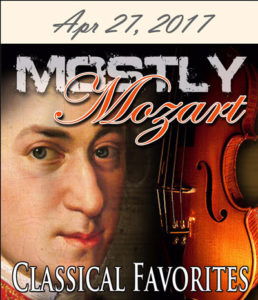Concert 5 Mostly Mozart
(with the Grand Symphony Chorus)
April 27, 2017 at 7:30 PM
Wine & Cheese Reception 6:30 pm
Cailloux Theater – Kerrville, Texas
Evening’s Performances
Mozart: Symphony No. 25 in G Minor: 1st movement
Mozart: Concerto for Flute and Harp: 1st and 2nd movements
Shana Norton, harp and Dani Rauschuber, flute
Mozart: Symphony No. 41 in C Major Jupiter: 1st movement
Mozart: Overture to The Magic Flute
Intermission
Mozart: Papagena and Papageno duet from Magic Flute
David Baker, baritone and Kara Joy Baker, soprano
Mozart: “Voi che sapete” from Marriage of Figaro
Kara Joy Baker, soprano
Mozart: Lacrimosa and Dies Irae from Requiem Mass in D Minor
Verdi: Libiamo from La Traviata
Conductor’s Letter
Dear Symphony of the Hills Friends,
Our final concert of the season will feature the music of Wolfgang Amadeus Mozart and some of his followers. Mozart, unlike J.S. Bach, was popular and often-performed during his brief lifetime. From his first performances as a child prodigy until his tragic death at the age of 35, Mozart was the composer most in demand in the second half of the 18th century. After his death he has remained as the most often-performed composer to this day. A remarkable and lasting legacy.
The concert will begin with his dramatic Symphony No. 25 in G Minor, the iconic music chosen for the opening of the multiple Academy Award-winning movie Amadeus. You will also hear the beautiful Concerto for Flute and Harp, featuring Symphony of the Hills principal players Dani Rauschuber, flute, and Shana Norton, harp.
The second half of the program will feature a collaboration with our Grand Symphony Chorus, directed by David Baker, in highlights of Mozart’s opera The Magic Flute. We will conclude the performance with one of the most uplifting musical works written, Wagner’s “Pilgrim’s Chorus” from his opera Tannhäuser.
This will be a special evening as we celebrate perhaps the greatest artist of Western Civilization. We hope you will experience this profound concert and continue to support great music right in the heart of the Texas Hill Country.
Thank you for your attendance and continued support,
Gene Dowdy
Conductor & Artistic Director
Concert Notes
Mozart composed more than 600 works, many acknowledged as perfect representations of symphonic and choral music. He is among the most enduringly popular of composers during the Classical period, and his influence has been profound on subsequent Western composers. Beethoven scored his own early works in the shadow of Mozart, and Joseph Haydn wrote that “posterity will not see such a talent again in 100 years.”
It has been speculated that Mozart was poisoned and thereby died at the early age of 35. As with other mysteries concerning Mozart, the actual cause of his death is unknown, but it now seems probable that he died of rheumatic fever, since there was an epidemic in Vienna at that time.
Symphony No. 25 in G Minor (1st Movement)
Wolfgang Amadeus Mozart (1756 – 1791)
It has been well established that Mozart wrote 38 symphonies; the authorship of another three originally attributed to him is doubtful and that of at least 20 other symphonies cannot be confirmed because the scores are missing. In any case his output of symphonies was manifold; he wrote his first symphony at the age of 8. He wrote Symphony No. 25 when he was 17. It is sometimes known as Mozart’s “little” G minor Symphony, with reference to the sublime later “Great” G minor Symphony No. 40. In the nineteenth century No. 25 was little known and rarely performed, a situation that changed dramatically in the following century. Indeed, with the popularity of the movie Amadeus, which uses the first movement of No. 25 in ways that would surprise the composer, the piece has achieved a familiarity on a par with that of his No. 40. Symphony No. 25 was Mozart’s first symphony in a minor key; he wrote only two in that key.
Concerto for Flute and Harp (1st & 2nd Movements)
Wolfgang Amadeus Mozart
Featuring: Shana Norton on Harp and Dani Rauschuber on flute.
This piece for flute, harp and small orchestra was written by Mozart expressly to please an audience. It was commissioned by the Duc de Guines, a superb amateur flautist, to be played by the Duke and his harpist daughter, also a very good musician. Shortly after Mozart’s arrival in Paris with his mother in 1778, she wrote to her husband in Salzburg about the concerto and Mozart’s employment to teach composition to the Duke’s daughter. This was quite an honor, but the pleasure began to wane when it became clear that the Duke was in no hurry to compensate Mozart for the work. The piece itself has a sunny, tender character with a courtly graciousness, perhaps a reflection of lovely days in Paris.
The 1st Movement is a highly melodic, rather contemplative movement. The flute and harp duet passages with a silent orchestra are sparkling, with surprising returns to a minor key. It has been said that without this aspect the entire concerto would be “too happy to bear.” The flute and harp concerto was intended to be heard in a royal home, in a chamber music setting. In Mozart’s day the harp had not been refined to provide the necessary volume for a large concert hall, nor had it earned a place in the orchestras of the period. This upbeat blend of harp and flute works so well one is left to wonder why other composers failed to pursue this combination of voices.
Symphony No. 41 in C Major (Jupiter)
Wolfgang Amadeus Mozart
Mozart wrote his final three symphonies (39, 40 and 41) in a span of less than three months during the summer of 1788. Taken as a set, these works represent a diverse summary of Mozart as a mature artist and provide a good representation of the symphony form in the late 18th century. Symphony No. 41 is brilliant. Listening to this music leaves one to ponder the possibilities of a No. 42, which was never to be. Mozart was going through a very nasty personal period in 1788, but his No. 41 is surprisingly bright and effervescent.
Although the title “Jupiter” did not originate with the composer himself, it certainly fits this regal final symphony from the undisputed master of this classical form. It is probable that No. 41 was never performed in a concert hall during Mozart’s lifetime; regrettably his flagging spirits were not lifted by the critics’ almost universal adulation.
Overture to The Magic Flute
Wolfgang Amadeus Mozart
Four of the selections this evening, including this one, are from The Magic Flute (Die Zauberflöte), Mozart’s penultimate opera, written during the extremely fertile last year of his life in 1791. The opera in two acts is an example of the dramatic style popular at the time, known as Singspiel (a blend of singing and spoken text,) and is believed by some to be an allegory on Mozart’s Masonic associations and beliefs. He would live to see it successfully staged and he actually conducted the premiere performances, though his death just months later would deprive him of knowing how lasting the work would become.
The Magic Flute is a fairy tale, with simple themes of love and of good versus evil, but having a complex and imaginative plot. To kick off the story, the Queen of the Night persuades Prince Tamino to rescue her daughter Pamina from captivity under the high priest Sarastro. She promises him Pamina’s hand in marriage and gives him a magic flute. In a plot twist, Tamino joins Sarastro’s group when he learns that Sarastro is kind and wise and the Queen of the Night is evil. Sarastro puts Pamina and Tamino through severe trials of initiation involving fire and water. They survive that ordeal by using the magic flute. The earthy Papageno, a bird catcher who has accompanied Tamino on his quest, fails the initiation but is rewarded anyway with the hand of his young and pretty female companion Papagena. United, the happy couple stutter in astonishment and make bird-like courting sounds at each other. They plan their future and dream of the many children they will have together; since it’s an opera, they sing:
Papageno and Papagena Duet
Wolfgang Amadeus Mozart
Kara Joy Baker, Soprano and David Baker, Baritone
and live happily ever after. The evil Queen of the Night, who is quite upset with all the love and success, attempts to destroy the temple but she and her cohorts are cast into the darkness.
“Voi Che Sapete” (from The Marriage of Figaro)
Wolfgang Amadeus Mozart
Kara Joy Baker, Soprano
This piece is an orchestral version of a very popular aria from Mozart’s Le nozze di Figaro (The Marriage of Figaro), one of the most beloved and performed operas in today’s standard repertoire. This opera buffa (Italian for comic opera) was composed in 1786, based on a 1784 stage comedy by Pierre Beaumarchais. Beaumarchais’s play is the second in his Figaro trilogy of plays, and follows the action of his first comedy The Barber of Seville. Both of these plays are examples of light comedy in the eighteenth century, immortalized by the operas of Rossini and Mozart.
Mozart’s tuneful melody is first heard in the opening measures of the accompaniment, where it is given emphasis against the backdrop of pulsating sixteenth notes. Both keyboard and vocal parts are performed lightly with two constant beats per measure, clearly pronounced.
Lacrimosa & Dies Irae from Requiem Mass
Wolfgang Amadeus Mozart
There’s a seductive, chilling mystery around the story of Mozart’s Requiem – it has almost everything: 1) a genuinely weird commission (of 60 ducats) from an attorney who asked Mozart to write the piece for Count von Walsegg, the attorney’s client; 2) the pretentious count planning to pass off the piece as his own composition to commemorate the death of his wife; 3) young Mozart writing his first setting of the Mass for the Dead, and finally . . . 4) Mozart’s tragically early death at the age of 35 before he finished the musical material.
Mozart wrote much of the Requiem Mass in D Minor in Vienna during the final months of his life in 1791, but only got through the first eight bars of Lacrimosa. He died in December of that year. A finished version has been (tentatively) attributed to Süssmayr in 1792, who stated that he used “scraps of paper” left behind by Mozart, plus some contributions of others. History records that Mozart’s widow, Constanze, was involved in getting the work finished because she was broke (a rather surprising development, since Mozart’s annual income was averaging about 900 ducats/annum . . . crudely equivalent to about $140,000 today.) She apparently sold one copy of the work for 100 ducats and a few other copies for untold sums. With all this intrigue, there is considerable confusion about who did what and when they did it.
Dies Irae (Day of Wrath,) of which the Lacrimosa is a part of the overall sequence, is a 13th Century hymn best known from its use as a sequence in the Roman Catholic Requiem Mass. It has been an element of the Mass for centuries and is still heard where the Latin liturgy is celebrated.
Libiamo from La Traviata
Giuseppe Verdi
“Libiamo ne‘ lieti calici” (“Let’s drink from the joyful cups”) is a famous duet with chorus from Verdi’s La Traviata. Libiamo is one of the most widely performed opera melodies and a popular choice (as is this opera itself) for tenors the world over. The song is a brindisi, a lively toast embracing the considerable consumption of wine and other alcoholic beverages. The duet is performed in the first act of the opera during a party at Violetta Valéry’s house. It is sung by Violetta and Alfredo Germont, a young man who is in love with her. Alfredo apparently wants to show off his voice and so begins this drinking song, later joined by Violetta and the rest of the company. A good time is had by all.
Concert Notes by Jim Adams



